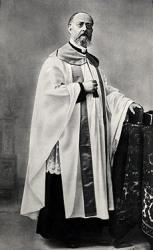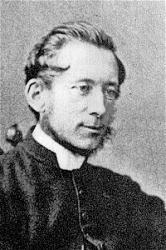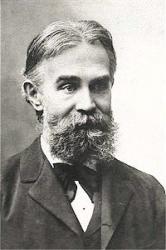Planning worship?
Check out our sister site, ZeteoSearch.org,
for 20+ additional resources related to your search.
- |
User Links
Person Results
Greg Scheer

b. 1966 Arranger of "NICAEA" in Sing With Me Greg Scheer is a composer, author, and speaker. His life’s work includes two sons (Simon and Theo), two books (The Art of Worship, 2006, and Essential Worship, 2016), and hundreds of compositions, songs, and arrangements in a dizzying variety of styles.
Greg is also co-founder of Hymnary.org and source of many ideas and inspirations, some good.
Greg Scheer
Greg Scheer
Juan Bautista Cabrera Ivars

1837 - 1916 Person Name: Juan Bautista Cabrera Translator of "¡Santo! ¡Santo! ¡Santo!" in The United Methodist Hymnal Juan Bautista Cabrera Ivars was born in Benisa, Spain, April 23, 1837. He attended seminary in Valencia, studying Hebrew and Greek, and was ordained as a priest. He fled to Gibraltar in 1863 due to religious persecution where he abandoned Catholicism. He worked as a teacher and as a translator. One of the works he translated was E.H. Brown's work on the thirty-nine articles of the Anglican Church, which was his introduction to Protestantism. He was a leader of a Spanish Reformed Church in Gibraltar. He continued as a leader in this church when he returned to Spain after the government of Isabel II fell, but continued to face legal difficulties. He then organized the Spanish Reformed Episcopal Church and was consecrated as bishop in 1894. He recognized the influence of music and literature on evangelism which led him to write and translate hymns.
Dianne Shapiro, from Real Academia de la Historia (https://dbe.rah.es/biografias/39825/juan-bautista-cabrera-ivars) and Himnos Cristanos (https://www.himnos-cristianos.com/biografia-juan-bautista-cabrera/) (accessed 7/30/2021)
Juan Bautista Cabrera Ivars
John Bacchus Dykes

1823 - 1876 Person Name: John B. Dykes Composer of "NICAEA" in Psalter Hymnal (Gray) As a young child John Bacchus Dykes (b. Kingston-upon-Hull' England, 1823; d. Ticehurst, Sussex, England, 1876) took violin and piano lessons. At the age of ten he became the organist of St. John's in Hull, where his grandfather was vicar. After receiving a classics degree from St. Catherine College, Cambridge, England, he was ordained in the Church of England in 1847. In 1849 he became the precentor and choir director at Durham Cathedral, where he introduced reforms in the choir by insisting on consistent attendance, increasing rehearsals, and initiating music festivals. He served the parish of St. Oswald in Durham from 1862 until the year of his death. To the chagrin of his bishop, Dykes favored the high church practices associated with the Oxford Movement (choir robes, incense, and the like). A number of his three hundred hymn tunes are still respected as durable examples of Victorian hymnody. Most of his tunes were first published in Chope's Congregational Hymn and Tune Book (1857) and in early editions of the famous British hymnal, Hymns Ancient and Modern.
Bert Polman
John Bacchus Dykes
Timothy T'ingfang Lew
1891 - 1947 Person Name: 劉廷芳 Translator of "聖哉三一歌" in The Cyber Hymnal T'ingfang Lew was a leading Chinese educator, author, and editor. He was educated in China and at Columbia University in New York City (M.A.; Ph.D.). His Bachelor of Divinity degree was from Yale and he studied at Union Theological Seminary, New York City, where he also taught Christian education. Lew lectured throughout America at schools and colleges from 1926 to 1938 and received an S.T.D. degree from Oberlin College.
In 1932, Lew began to chair the commission to prepare a Chinese Union hymnal. The resulting Hymns of Universal Praise was published in 1936. Its music editor was Bliss Wiant, a colleague of Lews's at Yenching University in Peking. Lew also edited the Union Book of Common Prayer which was used by four Protestant Chinese groups having approximately one-half million members. He represented China at the World Council of Churches meetings (1927-1939). He served as a member of the Chinese government's legislative body (1936-1941).
Lew is remembered for his work with Chinese Christian organizations in China and America where he resided from 1941 to 1947. He died while teaching at the University of New Mexico.
--The Presbyterian Hymnal Companion, 1993
Timothy T'ingfang Lew
David McK. Williams
1887 - 1978 Person Name: David McKinley Williams, 1887-1978 Composer (desc.) of "NICAEA" in Psalter Hymnal (Gray) David McKinley Williams (Conductor)
Born: February 20, 1887 - Carnarvonshire, Wales, UK
Died: March 13, 1978 - Oakland, California, USA
The Welsh-born American church musician, composer, and teacher, David McKinley Williams, began his career in church music as a chorister in the choir of the Cathedral of St. John, Denver. At the age of 13 he became the organist of St. Peter's Church, Denver.
In 1908 David McKinley Williams went to New York to serve as the organist of Grace Church Chapel. He moved to Paris in 1911 for study with some of the best known French organists of the time. Upon his return, he served as organist of the Church of the Holy Communion in New York. He served in the Royal Canadian Artillery in World War I and returned to his New York position in 1920. After only six months, he was appointed organist and choirmaster of St. Bartholomew's Church, New York. He held this position until his retirement in 1947.
David McKinley Williams developed one of the most outstanding music programs in the USA at St. Bartholomew's. He was head of the organ department of the Juilliard School of Music and a member of the faculty of the School of Sacred Music, Union Theological Seminary. He also served as a member of the Joint Commission on Church Music and the Joint Commission on the Revision of the Hymnal that produced The Hymnal (1940). The Hymnal 1982 uses five of his tunes, including MALABAR used with "Strengthen for Service" (Hymn 312), CANTICUM REFECTIONIS, used with "This is the hour of banquet and of song" (Hymn 316), and GEORGETOWN, used with "They cast their nets in Galilee" (Hymn 661).
Source: The Episcopal Church - Liturgy Music Website
David McK. Williams
Robert II, King of France
970 - 1031 Person Name: Roberto II de Francia Author of "Pidiendo el don del Espíritu" in Himnario de la Iglesia Metodista Episcopal Robert the Second, King of France, surnamed "Le Page" and "Le Devot," born circa 970, was the son of Hugh Capet, the first of the line of kings that succeeded the Carlovingian monarchs on the French throne. After having been associated with his father in the government of the kingdom, in 988 he became king in his own right. The story of his life, rather than of his reign, is a sad one; troubles both in his family and without so multiplying upon him that it needed all the consolation that he sought and found in religion to enable him to bear up against them. Having in 995 or 996 espoused Bertha, the widow of Eades, Count of Chartres, and daughter of Conrad the Pacific, his cousin in the fourth degree (a marriage at that time strictly forbidden by the Roman Catholic Church), he was commanded by a decree of Pope Gregory V. to put her away. He was tenderly attached to her, and refused, whereupon he was excommunicated. This sentence caused the unhappy couple to be abandoned by all their courtiers, and even their servants, with the exception of two of the latter. After living together for a while in a state of sore privation, nay, almost absolute destitution, Bertha was delivered of a still-born infant, which was represented to Robert to have been a monster with “a head and neck like a goose." On hearing this (for the fond husband was but a weak and credulous man), Robert repudiated his wife, who thereupon retired into a nunnery.
Subsequently, probably about 1002, he married Constance, a daughter of the Count of Aries, by whom he had four sons and two daughters. Much of the misery of his later life resulted from this marriage; for in addition to the antagonism which existed in their tastes and pursuits, Constance endeavoured to secure the kingdom for her youngest son Robert, to the exclusion of the third son Henry (Hugh, the eldest, haying died, and Eudes, the second, being an idiot), and this led to constant domestic broils which embittered the gentle king's existence. In 1024 he refused (and wisely) the Imperial Crown of the House of Saxony, when the Italians offered it to him on the death of Henry II., the last of the Saxon Emperors. Robert spent much of his time in the society of monks, assisting in the services of the Church, and engaging on pious pilgrimages. It was upon his return from one of the latter to some of the principal sanctuaries of France that he was attacked by a fever, to which he succumbed at Thelun in 1031, in the 60th year of his age and the 34th of his reign more deeply lamented by his people, to whom he had attached himself by the sweetness and simplicity of his character, than any other king, probably, who ever reigned in France. Robert had a great love for, and skill in, church music, and it is not improbable that compobitions of his are even at this day in use in the services of his Church. [Rev. Digby S. Wrangham, M.A.]
It has been the custom to speak of King Robert as a hymn-writer. But when the different authorities come to specify the pieces which he is said to have composed, their statements are hopelessly at variance. For the purposes of this article we shall take four ancient authorities:—
(a) and (b) In the Recueil des Historiens des Gaules et de la France, vol. x., Paris, 1760, pp. 297-300, there are extracts "ex chronico Sithiensi" (a); and also "ex chronico Alberici ad annum 997 " (b).
(c) In the Junius manuscript, 121, in the Bodleian there is a list of authors of sequences, written about 1300.
(d) William Durandus (d. 1296) in his Rationale, Bk. iv., has a section "De prosa seu sequentia." This occurs in two manuscripts of the 14th century in the British Museum [Add. 18304, f. 20 b; Reg. 7 E., ix. f. 53. An earlier and finer manuscript than either (Add. 31032) has unfortunately lost the leaf containing this section].
By these four authorities the following hymns and sequences are ascribed to King Robert :—
1. Chorus novae Hierusalem.
2. Rex omnipotens die hodierna.
3. Sancti Spiritus adsit nobis gratia.
4. Veni Sancte Spiritus.
5. Victiniae Paschali.
But of these a only ascribes to him No. 3, and does not mention Nos. 1,2, 4 or 5, while b ascribes to him Nos. 2 and 3, and does Dot mention Nos. 1, 4 or 5. On the other hand c ascribes to him No. 5, while No. 3 it ascribes to Hermannus Contract us, and Nos. 1, 2, 4 it does not mention at all. Lastly d ascribes to him Nos. 1 and 4, but ascribes Nos. 2 and 3 to Hermannus Contractus, and does not mention No. 5. Taking these in detail, we find No. 1 is only ascribed to King Robert by d, and seems more probably to be by Fulbert of Chartres (see p, 224, i.). No. $. seems without doubt to be by Notker Balbulus (see note on "Sancti Spiritus adsit"). For No. 5 see note on "Victimae Paschali." No. 2 is noted at p. 958, ii, and, according to the common opinion, is there ascribed to Hermannus Contractus; but this ascription is very doubtful, seeing that he d. in 1054, and was only b. in 1013, while the Bodleian manuscript 775 was written in England about 1000, so that the ascription of b deserves attention. As to No. 4 the subject of authorship is treated more fully under "Veni Sancte Spiritus," but here it may be said that Durandus and those who followed him are alone in ascribing it to King Robert, for the French tradition was clearly against this, e.g. neither a nor b ascribe it to him, and Clichtovaeus in his Elucidatorium, Paris, 1516, and the Augustinian Missal, printed at Paris, 1529, which may be taken to represent the later French tradition, while agreeing in ascribing No. 3 to King Robert, agree also in treating No. 4 as of un¬known authorship. To sum up then it seems to us that No. 2 is possibly by King Robert; that Nos. 3 and 4 are clearly not by him; and that his claim to Nos. 1 and 5 is exceedingly doubtful.
The French chronicles a and b as above also ascribe to King Robert other liturgical pieces, viz.:—(1) "O Constantia martyrum," (2) "Judaea (O Juda) et Hierusalem," (3) "Eripe me," (4) " Ounctipotens genitor"(5) "Cornelius centurio," (6) "Pro fidei meritis," (7) “Concede nobis quaesumus." These appear to be Responsories and Antiphons, but whether rightly or wrongly ascribed to Robert the present writer cannot say. No. 7 is also ascribed to him by c as above. [Rev. James Mearns, M.A.]
--John Julian, Dictionary of Hymnology (1907)
Robert II, King of France
Alan Gray
1855 - 1935 Composer (organ descant) of "NICAEA" in The United Methodist Hymnal Music Supplement Born: December 23, 1855, York, England.
Died: September 27, 1935, Cambridge, England.
Buried: Trinity College, Cambridge, England.
Alan Gray (23 December 1855, York – 27 September 1935, Cambridge) was a British organist and composer.
Born in York, he attended St Peter's School in York and Trinity College, Cambridge. From 1883 until 1893 he was Director of Music at Wellington College. In 1893 he returned to Cambridge to be organist at Trinity College, and remained organist there until 1930.
Among his compositions are liturgical music for Morning and Evening Prayer and the Office of Holy Communion for use in the Church of England according to the Book of Common Prayer, including an Evening Service in f minor, a setting of Holy Communion in G, several anthems, including 'What are these that glow from afar?', and a collection of descants to various hymn tunes, several of which are still in use today (Common Praise (2000) includes four). He also composed a number of items for organ, for violin solo, and for voice and orchestra to religious and secular texts.
--en.wikipedia.org/wiki/
Alan Gray
William Channing Gannett

1840 - 1923 Person Name: William C. Gannett Author of "Who Wert and Art and Evermore Shalt Be" in The Pilgrim Hymnal Gannett, William Channing, M.A., s. of Dr. Ezra Stiles Gannett, was b. at Boston, March 13, 1840, and educated at Harvard College, 1860, and the Divinity School, Cambridge. Entered the Unitarian Ministry in 1868, and after filling several pastorates he became Pastor of the Unitarian Church at Rochester, N.Y., 1889. Mr. Gannett's hymns, mainly written for special occasions, were included in great part in The Thought of God in Hymns and Poems, Boston, 1st Series 1885,2nd Series 1894,
the combined production of F. L. Hosmer (q.v.) and himself. Of Mr. Gannett's hymns the following are in common use:—
1. Bring, 0 morn, thy music [God Everlasting.] Written in 1893, and printed in A Chorus of Faith, being an account and resume of the Parliament of Religions, held in Chicago, 1893. Included in The Thought of God, 2nd Series, 1894, and again in several hymnals.
2. Clear in memory's silent reaches. [Memory.] Written in 1877 for a Free Religious Assoc. Festival, and published in The Thought of God, 1st Series, 1885.
3. Prom heart to heart, from creed to creed. [Faith.] Written in 1875 for the 150th anniversary of the First Religious Society in Newburyport, and given in The Thought of God, 1ist Series, 1885. Usually st. ii. is omitted.
4. He hides within the lily. [Divine Providence.] "Consider the lilies, how they grow." Written in 1873, and printed for use at the Free Religious Assoc. Festival, May 30th, 1873. Published in The Thought of God, &c, 1st Series, 1885, in 4 stanzas of 8 lines. The most widely used of the author's hymns.
5. I hear it often in the dark. [The Voice of God.] Written at Milwaukee, in 1870, and published in The Thought of God, &c, 1st Series, 1885. Sometimes it begins with st. iii., "0 God within, so close to me," as in Hymns for Church and Home, Boston, 1895.
6. Praise to God and thanksgiving. [ Harvest.] Written in 1872 for a Harvest Festival at St. Paul's, Minn., of which he was then Pastor, and included in The Thought of God &c, 1st Series, 1885. in the Boston Pilgrim Hymnal, 1904, it begins "Praise to God, and thanks we bring."
7. Sleep, my little Jesus. [ Christmas Carol.] Written for the Sunday School, St. Paul's, Minn., in 1882, and given in The Thought of God, 2nd Series, 1894, as "Mary's Manger Song."
8. The Lord is in His holy place. [Dedication of a Place of Worship.] Written for the Dedication of the Rev. C. W. Wendte's Church, Chicago, April 24, 1873, and pub. in The Thought of God, &c, 1st Series, 1885. It is one of the most popular and widely used of the author's hymns.
9. The morning hangs its signal. [Morning.] This is dated by the author "Chicago, July 30, 1886," and printed in Love to God and Love to Man, being No. 28 ot the Chicago "Unity Mission" series of hymns (N.D.). Also included in The Thought of God, &c, 2nd Series, 1894. Although in some sense a Morning hymn, it is adapted for use in Advent. It is usually known as “The Crowning Day."
10. The Truth is the Voice of God. In the "Unity Mission" Series, No. 28 (see above), this is given as No. 33, with the title "Truth and Righteousness and Love," in 4 stanzas of 4 lines and a refrain of 4 lines.
These annotations are based upon manuscript notes kindly supplied by the author. The use made of Mr. Gannett's hymns shows that their poetic beauty and loving sympathy with all things beautiful and pure, are widely appreciated in America and to a limited extent in Great Britain also.
--John Julian, Dictionary of Hymnology, New Supplement (1907)
William Channing Gannett
John Dykes Bower
1905 - 1981 Person Name: John B. Dykes, 1823-76 Composer of "NICAEA" in Lutheran Worship Sir John Dykes Bower CVO (13 August 1905 – 1981) was an English cathedral organist, who served in Truro Cathedral, Durham Cathedral and St Paul's Cathedral.
John Dykes Bower was born on 13 August 1905 in Gloucester. He was one of four brothers. Stephen Dykes Bower became a famous church architect.
He was educated at Cheltenham College and studied organ under Herbert Brewer, and was organ scholar at Corpus Christi College, Cambridge from 1922.
He was organist of:
Truro Cathedral 1926 - 1929
New College, Oxford 1929 - 1933
Durham Cathedral 1933 - 1936
St Paul's Cathedral 1936 - 1968
--en.wikipedia.org/wiki/
John Dykes Bower


 My Starred Hymns
My Starred Hymns


